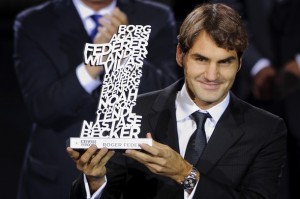If you turn to the September 20 chapter of the “On This Day In Tennis History” book, you will see that it was on this day in 1973, perhaps the most famous and most watched per capita tennis match took place. Of course, it is the “Battle of the Sexes” match between Billie Jean King vs. Bobby Riggs.
The following is the excerpt from the “On This Day In Tennis History” book followed by how the one and only Bud Collins described the historic event in the 1973 chapter of his tennis encyclopedia “The Bud Collins History of Tennis.”
September 20, 1973 – In perhaps the most socially significant event in the history of tennis and sports history, 29-year-old Billie Jean King defeats 55-year-old Bobby Riggs 6-4, 6-3, 6-3 in 2 hours, 4minutes to win the “Battle of the Sexes” played at the Houston Astrodome in Houston, Texas. The match is played in a circus-like atmosphere in front of a world record crowd of 30,492 fans and millions in front of televisions around the world. “She was too good,” says Riggs, the 1939 Wimbledon champion, following the match. “She played too well. She was playing well within herself and I couldn’t get the most out of my game. It was over too quickly.” Writes Neil Amdur of the New York Times, “King struck a proud blow for herself and women around the world.”
The landmark match of the year did not come in any of the traditional major tournaments. There was nothing traditional at all about the celebrated “Battle of the Sexes” between 29-year-old Billie Jean King and 55-year-old Bobby Riggs, the self-proclaimed “King of Male Chauvinist Pigs,” at Houston’s Astrodome the night of September 20. But this spectacle—roughly equal parts tennis, carnival, and sociological phenomenon—captured the fancy of America as no pure tennis match ever had. The shlockathon meant nothing and yet it meant everything: it had no bearing on the game of tennis, yet it stirred the populace. The crowd of 30,472, paying as much as $100 a seat, was the largest ever to witness a tennis match. Some 50 million more watched on prime-time television. The whole gaudy promotion was worth supposedly $3 million, and King collected a $100,000 alleged winner-take-all purse, plus ancillary revenues, for squashing Riggs, 6-4, 6-3, 6-3. He got a big chunk of cash, too.
Riggs, the outspoken hustler who had won Wimbledon and U.S. Championships in 1939, created the bonanza by a challenge proclaiming that women’s lib was a farce and that the best of the female tennis pros couldn’t even beat him, “an old man with one foot in the grave.” He challenged Margaret Smith Court to a winner-take-all challenge match on Mother’s Day at a California resort he was plugging in Ramona. She was the ideal victim for his well-perfected “psych job” and assortment of junk shots, including lobs into the sun at high noon. Margaret choked and Riggs won, 6-2, 6-1. That set the stage for the haranguing challenge against Billie Jean, the leading voice of women’s lib in sports. The whole ballyhooed extravaganza was just right for the times, and it became a national media event, front-page news in papers and magazines across the country, even the world. King exulted in her victory, not as a great competitive triumph but as “a culmination” of her years of striving to demonstrate that tennis could be big-league entertainment for the masses, and that women could play.






